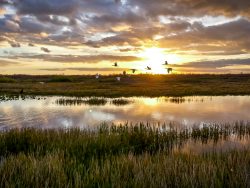
Advocate for lasting change
By Daniel Hayden
Last month, I wrote about how Springtime is a great chance to participate in restoration projects, beach cleanups, and other volunteer events in your community. These are great ways to improve our environment, meet new people, and enjoy the outdoors. If you have not signed up for a community event yet, here’s a great place to start!
All that said, as we look at the scale and scope of the challenges that face our coastal regions, these volunteer opportunities are not the solution, but the genesis of the solution: communities committed to restore and maintain their special places. The next step is clear policies that buttress this support.
First, we need to protect what we have. According to the U.S. Fish and Wildlife Service’s most recent Status and Trends of Wetlands in the Conterminous United States Report 2004-2009, we have lost over 84,000 acres, or 1.4%, of our wetlands just between 2004 and 2009.
This trend is simultaneously occurring on a global scale. The Global Wetland Outlook Report published in 2018 by the Ramsar Convention on Wetlands states that 35% of wetlands have been lost globally between 1970 and 2015. We need to support provisions like Section 404 of the Clean Water Act, which regulates the discharge of dredged or fill material into waters including wetlands.

Secondly, we need to stop the pollution. In addition to the aesthetic and health costs, pollution inhibits the natural regeneration process. We need to support policies that drive natural solutions to surface runoff by continuing to invest in programs like EPA’s Clean Water State Revolving Fund (SRF). We need to support farmers who create or maintain buffer zones along their waterways through cooperative programs, such as the Farm Bill. We need to invest in municipal waste management to ensure trash is ecologically managed. Finally, we need to insist that companies move away from the single use mentality to a circle model that designs products so that they can be continually repurposed.
Thirdly, we need to invest in what we have. Programs such as NOAA’s Community Based Restoration Program, FEMA’s Building Resilient Infrastructure and Communities (BRIC), NWFW’s Coastal Reliance Grants and Restore America’s Estuaries’ own Coastal Watersheds Grant (CWG) Program, Tampa Bay Environmental Restoration Fund (TBERF), and Southeast New England Program (SNEP). These programs, and many more like them, create steady streams of funding for critical restoration projects. These projects build healthy habitats that reduce the impacts of storms, sequester carbon, and create recreational opportunities.
Last, we need to decarbonize our energy consumption. Green energy means stable, domestic jobs throughout our country. To our oceans, it means slowing the impacts of ocean acidification that are killing shellfish and warming waters that are changing fish habitat and disrupting ocean currents. Legislation like the Ocean-Based Climate Solutions Act of 2020 highlight the role that oceans can play in climate solutions.
So, after you participate in your community clean up, take the next step. Write your members of Congress, as well as state and local elected officials, and encourage them to support funding for coastal restoration. Share your success stories with them, and with us! Tag them in social media posts, email them photos and project reports, and, most importantly, ask them to come visit to see for themselves.
 Cheers,
Cheers,
Daniel Hayden
President & CEO
Restore America’s Estuaries
